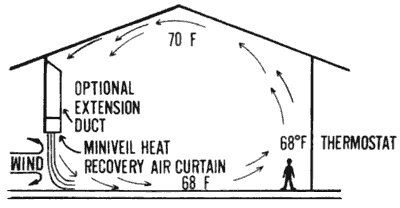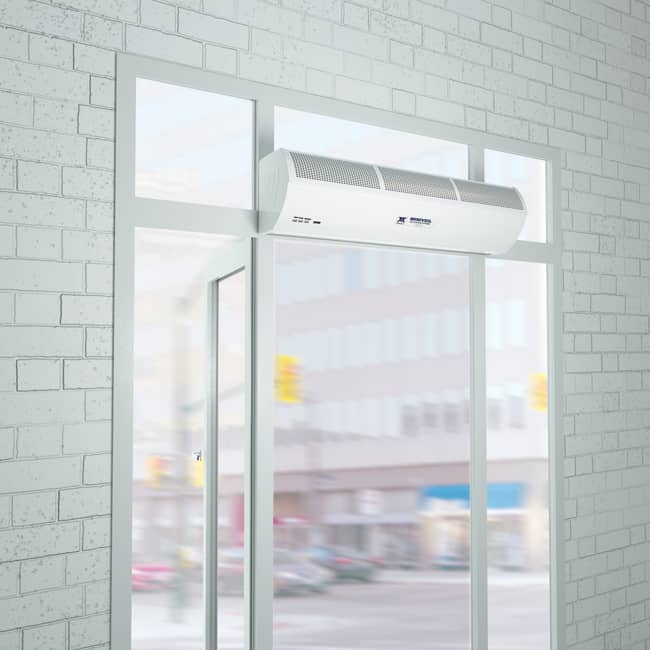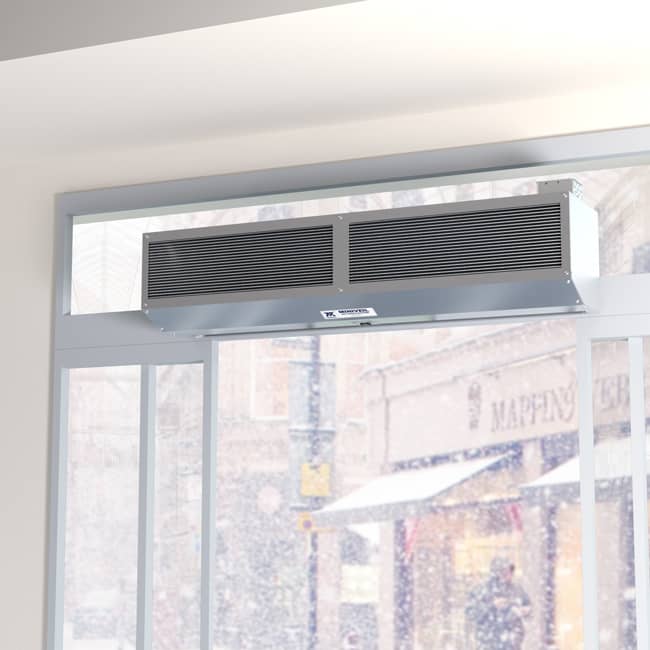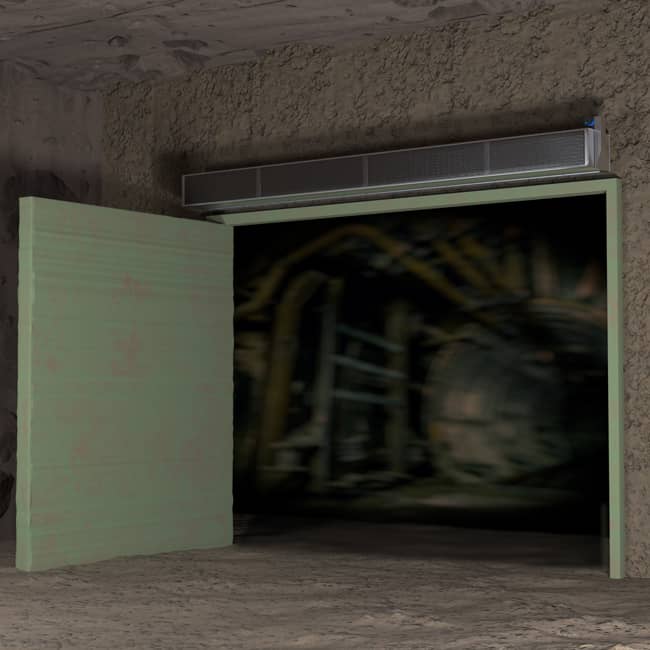Industrial Climate Control
The primary purpose of the Climate Control Air Curtain is to prevent the influx of outside air through an opening in to heated or cooled area. Opening where an Air Curtain would typically be used are exterior shipping and receiving doors to plants and warehouses and interior doors between plant areas of different temperatures. (these applications are discussed in further detail below). In addition there are special applications such as the control of oven temperature, humidity and dust or the control of the fresh air . Other applications not discussed here are preventing the drifting of over spray from spray paint booths; blowing water off of hot steel after it has been dipped; and blowing scrap paper from a paper cutter into a collecting intake.
In order to control climate an Air Curtain emits an air stream with enough velocity at the nozzle and the width of the nozzle. For different door sizes and different wind conditions , different air velocities at the nozzle are required.
To prevent the entry of outside winds the discharge nozzle is angled outward so that the air leaving it meets the wind trying to enter. The wind will meet or strike the Air Curtain stream in the doorway. This working principle is shown in the figure below:

When the vector representing the air stream and the vector representing the wind equalize they form a resultant which should meet the floor in the door plane for maximum efficiency.
In many buildings with high ceilings the air tends to stratify into a warmer layer at the ceiling and a considerably cooler one at the floor. For such buildings it is recommended that the air curtain be mounted across the top of the doorway opening and that it be provided with a top intake connected to a duct extending up to the ceiling. (as illustrated):

The warm air will then be drawn down into the Air Curtain and blown to the floor putting otherwise wasted heat to use. This warmer air also helps to reduce the wind chill of the moving air.
Commercial Entrances
Commercial Entrance Air Curtains are becoming widely used in building entrances to reduce energy consumption and provide comfort. In winter they retain warm inside air and prevent the influx of cold air. They can also supply additional heat in the door area using optional electrical, steam or hot water heaters. In the summer Air Curtains keep hot humid air out and prevent the escape of air conditioning. The working principle of Commercial Entrance Air Curtains is to provide the most effective air screen possible without blowing so hard that it is objectionable to people passing through.
Air Curtains are ideal for application on high traffic doorways in commercial establishments such as stores, restaurants and banks. They are also ideal for public buildings such as hospitals, terminals and schools. In many cases where a vestibule was installed, or planned, to reduce the inflow, an Air Curtain is a better approach. This is particularly true for high traffic entrances where both doors are frequently open at the same time, defeating the purpose of the vestibule. A continuously operating Air Curtain allows the vestibule to be dispensed with resulting in large savings — both in initial and operating costs — and increasing the usable floor space.
Commercial Entrance Air Curtains are normally mounted horizontally above the door which keeps the unit out of the way and practically eliminates any chance of damage and/or accidents. During the heating season, the air stream should be directed slightly toward the outside and should never be obstructed by door operators or the door header.
It is recommended that the Air Curtain fan motor be run continuously, since the power needed to operate it is minimal.
It is preferable to control the heater in heated units with a built-in, or wall mounted, thermostat, in order to maintain a constant, comfortable temperature in the entrance area. In addition to providing comfort through the elimination of cold drafts and the addition of heat to door areas. Commercial Entrance Air Curtains have many other benefits. For example, they can decrease door maintenance costs since doors need to be opened and closed left often. In restaurants they stop uncomfortable cold drafts at customer’s feet. Many schools purchase Air Curtains to save energy and find that, as an additional benefit, they keep floors dry and safe and hallways warm during the winter months. In buildings with high ceilings the Air Curtain re-circulates the warm stratified air that rises to the ceiling.
Commercial Entrance Air Curtains are quiet and compact and pay for themselves in a very short time. Most units may be used all year round and are adjustable for seasonal conditions using either a damper or a duel speed motor.
Insect Control
Insect Control Air Curtains, sometimes called “Fly Fans,” are used in food processing plants, dairies, bakeries, bottling plants, restaurants, supermarkets, hospitals, school cafeterias and other areas where the control of flying insects is required. The powerful stream of air that is produced by an Insect Control Air Curtain is an excellent deterrent to insects which will usually avoid the air stream simply because of it’s unnaturally high velocity.
The most effective Air Curtain design for insect control has a nozzle that can angle the air stream away from the area to be protected. An angle of about 20° from the vertical is usually optimal. The unit should meet or exceed Department of Agriculture and Federal Drug Administration standards, which call for an air stream 2-5 inches wide at the nozzle capable of producing a minimum velocity of 1600 fpm of air 3 feet above the floor and across the entire door opening. It is very important that the entire doorway be covered so that there are no gaps for the insects to enter.
The Insect Control Air Curtains can be mounted on the inside or outside of the doorway. When mounted on the inside the unit can help control the building’s climate in the winter by stopping the influx of cold outside air. (For more info on this effect see the Industrial Climate Control or Commercial Entrance Sections). When the building contains odours which are attractive to flying insects it is recommended that the Air Curtain be mounted on the outside.
When a negative pressure exists inside the building one of two approaches must be taken to make the Air Curtain fully effective in keeping the flying insects out. One alternative is to slightly alter the mounting of the unit, moving it out form the wall to relieve pressure on the Air Curtain and to allow the outside air to enter the building. The outside air will be drawn to the intake of the curtain through the gap between the wall and the unit. This gap must be covered by a screen and the gaps along the door jamb, caused by moving the unit back from the wall, should be closed by side panels.
The Air Curtain is equally effective mounted horizontally or vertically. However, measures should be taken to prevent damage to the Air Curtain caused by traffic when mounted vertically.
Cold Storage
When opened a door separating a cold storage area from a warm room permits a substantial loss of refrigerated air. Warm air flows into the cold room through the lower part. This results in energy losses, safety hazards in the form of condensation and icing on the floor and fog in the doorway; and possibly food spoilage. Strip doors used on coolers and freezers to reduce these effects impair visibility and are unpleasant to pass through due to condensation and frosting and accumulate dirt and possible bacterial growth.
Studies have proven that Air Curtains, when properly sized and adjusted, are up to 85% efficient in controlling the flow of air through cooler and freezer doorways. If the cold storage door is open over one hour per day the Air Curtain is a cost effective way to save refrigeration costs.
Installed on the warm side of the doorway the Air Curtain emits an air stream which reaches the floor at an angle and splits into two separate air streams. By properly adjusting the volume of the air and the angle of the nozzle, one air stream is made to balance against the other which is trying to leave the cooled room, while the other counteracts the warm air trying to enter. The correct Air Curtain sizing and adjustments must be made for each specific application so that a narrow, high velocity, low volume stream of air is projected over the entire opening creating a sufficiently stiff curtain of air. Built-in adjustments in the Air Curtain must include fully adjustable mounting brackets, variable volume controls and individually adjustable louvers in the nozzle. The narrow nozzle limits the amount of air in the doorway area and hence the turbulence, thus increasing the efficiency of the unit.
In addition to providing a substantial energy savings and increased safety, Cold Storage Air Curtains can increase the time between defrosting almost four fold, depending on the particular freezer or cooler. Also, their ability to maintain the cold room temperature right up to the doorway improves product quality and increases the useful floor space.
Summary
Over the long life of an Air Curtain system, tremendous benefits can be realized which pay for the system many times over. Some of these include:
- Increased employee comfort.
- Energy savings through control of air transfer.
- Faster and safer traffic flow and increased production due to clear and open doorways.
- Door maintenance cost savings due to decreased breakdowns.
Increased usable space near door areas.
- Elimination of ice and fog in cold storage areas.
- Increased safety in door areas due to better visibility.



